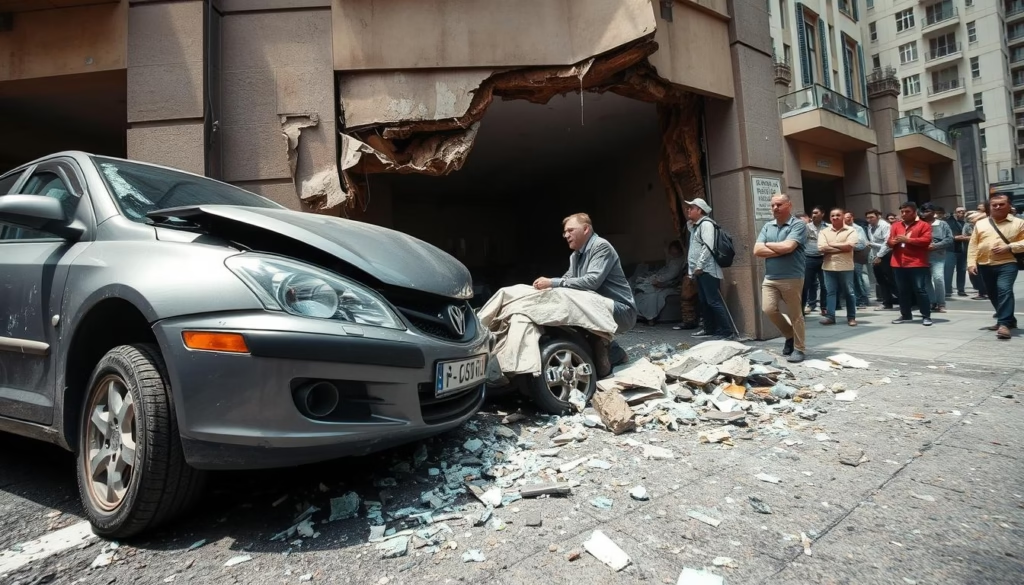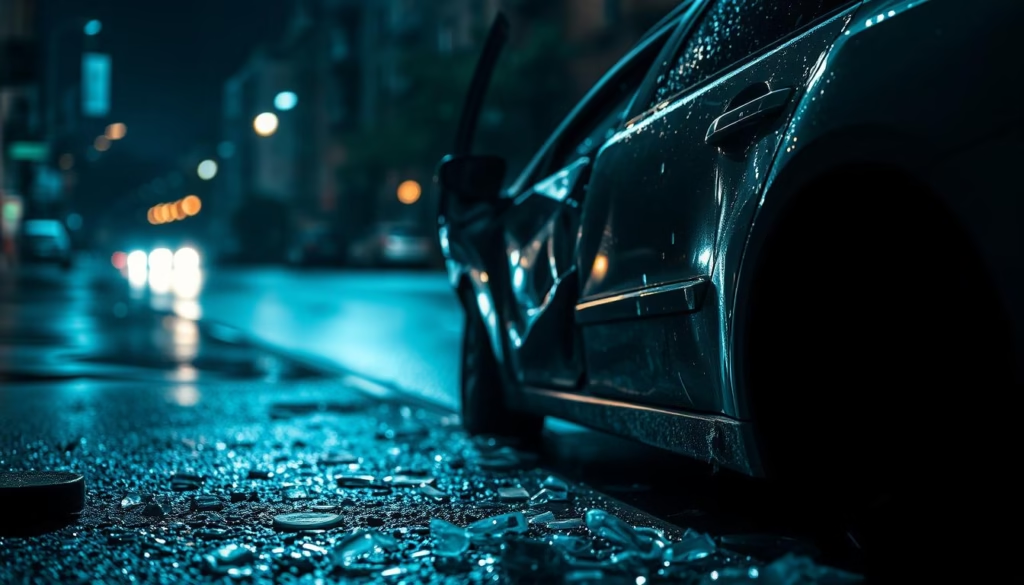Ready to rethink a common belief about liability after a crash? This section explains how property damage liability works when you cause harm to someone else’s vehicle or other items. It helps pay for repairs or replacement and can include legal defense costs tied to a covered claim.
This protection is one half of standard auto liability, paired with bodily injury liability, which handles medical costs for people hurt in a wreck. Unlike collision coverage, PD liability does not fix your own vehicle after an at-fault crash.
Limits are shown as split numbers like 50/100/25. The last figure is the per-accident PD limit. Most U.S. states require some amount of this liability, so it’s a legal must-have and a key financial safeguard.
Tip: Check your policy to see your limits and the specific property damage coverage line. Knowing your limits helps you avoid large out-of-pocket bills if total damages exceed your chosen amount.
Key Takeaways
- Property damage liability pays for others’ repaired or replaced items and related legal fees.
- It pairs with bodily injury liability as part of basic auto liability.
- Collision covers your own vehicle; PD liability does not.
- Split limits like 50/100/25 show PD as the last number — per accident.
- Most states require minimum liability limits; check your policy limits now.
Property damage liability at a glance for U.S. drivers
If you cause harm to another person’s vehicle or fixed object, a liability segment limits your out‑of‑pocket exposure. This line pays for repairs to another person’s items and can include legal defense costs tied to third‑party claims.
Key point: coverage and limits are different. Coverage defines eligible losses; limits set the maximum paid per accident. On a split limits policy like 50/100/25, the last number is the per‑accident PD limit—often too low for modern multi‑vehicle repair bills.
- Liability includes both bodily injury liability and property damage liability as standard auto liability.
- Collision is separate: it helps fix your own vehicle regardless of fault, usually required by lenders.
- Many states require minimum limits, but those minimums can fall short of real repair costs.
Want a quick reference for limits and duties? Read a clear summary on limits and legal duties here: property damage liability explained.
What does property damage car insurance cover
When you’re found at fault in a wreck, liability that pays for others’ losses steps in to handle repair and replacement bills.

Repairs and other damaged items
This line helps pay to fix another person’s vehicle you hit. It also covers harmed mailboxes, fences, garages, storefronts, utility poles, and landscaping.
Legal defense and related costs
If someone sues, the same liability can handle defense fees, settlements, and court costs tied to third‑party claims for covered losses.
What it won’t pay
Damage to your own vehicle after a fault accident is not paid here. That loss is handled by collision or other personal coverages on your policy.
How this differs from bodily injury liability
Think of two sides: bodily injury liability handles medical and injury costs for people, while property damage liability handles physical losses to items and structures.
Split limits explained
On a 50/100/25 policy, $25,000 is the PD limit per accident. Multiple vehicles and damaged structures in one crash share that single limit, so evaluate your limits against modern repair costs.
Coverage limits, per accident rules, and state minimums you should know (United States, present)
A single collision can hit multiple vehicles and structures, yet your policy usually pays up to one per‑accident maximum. This limit is the total your insurer will pay for covered losses from one crash, no matter how many items are affected.

Per accident explained
Per accident means the ceiling on payouts for all covered property loss in one incident. If three vehicles and a fence total $30,000 and your limit is $25,000, the insurer pays up to that limit and you may face the remainder.
Typical state minimum snapshots
- Common minimums include $10,000, $15,000, $20,000, and $25,000 per accident.
- Some states list as low as $5,000 — often too little for modern repair costs.
- Representative split limits: 25/50/10 ($10,000 PD), 25/50/15 ($15,000), 25/50/20 ($20,000), 25/50/25 ($25,000).
Special cases and combined single limits
Michigan is an exception: it offers $1,000,000 of in‑state property protection and $10,000 outside the state. Some states allow a combined single limit (CSL), such as $60,000 or $125,000, which pools BI and PD into one total.
Where to find your limit on your policy documents
Open the declarations page of your policy. Under liability you’ll see split numbers like 50/100/25 — the last number is the coverage per accident for property losses. The page also lists other lines such as medical payments or personal injury protection, depending on your state.
“Meeting the state minimum is a start, not a guarantee you won’t pay out of pocket after a multi‑vehicle crash.”
For a quick guide to state minimums and requirements, see minimum car insurance requirements.
How much property damage liability should you carry?
Deciding how much liability to carry starts with imagining a realistic accident cost and your financial safety net.
Real-world math: three-car chain-reaction
Example: a chain-reaction totals $23,000 (e.g., $10,000 + $8,000 + $5,000). With a $20,000 PD limit, the insurer pays up to that per accident and you might owe the remaining $3,000 personally.
Why exceed state minimums
State minimums give basic legal compliance, but modern repairs often cost more. Higher limits reduce the chance claimants seek recovery from your savings or wages.
When to add an umbrella policy
An umbrella policy sits above auto limits and provides extra liability per event once your auto limits are exhausted. It’s useful if your assets or risk exposure are significant.
PD vs. collision: rules to know
Note: PD liability is usually required by the state, while lenders often demand collision for financed or leased vehicles. Balance both when choosing limits.
- Consider higher limits if you drive in dense traffic or near expensive structures.
- Review both bodily injury liability and damage liability together for full protection.
- For more guidance on amounts, see a regional primer: how much coverage to carry and an overview of full coverage options: full coverage basics.
“Choosing limits above the legal minimum helps protect your savings after a multi-vehicle accident.”
Conclusion
A clear limit on liability is the line between insurer payment and personal expense.
Property damage liability helps pay for others’ repairs and legal fees when you’re at fault, while collision handles your own vehicle regardless of fault.
Remember that protection is capped by the PD limit per accident, so state minimums may leave gaps after multi‑vehicle incidents. Read your declarations page to find the PD number (often the last in split limits like 50/100/25) and confirm how bodily injury liability and PD work together for broader protection.
Consider an umbrella policy if you want extra liability coverage above auto limits. Quick action: check your current PD limit, compare it to likely repair costs nearby, and adjust to fit your comfort level. For details, learn more about bodily injury and property.
FAQ
What is property damage liability in auto policies?
Property damage liability pays for harm you cause to someone else’s vehicle or other tangible assets after a covered crash. It also covers reasonable legal fees and court costs if the other party sues you. This part of an auto policy protects your finances when you’re found at fault for damage to another person’s property.
How does this coverage differ from bodily injury liability?
Bodily injury liability handles medical bills, lost wages, and pain and suffering for people hurt in a crash you cause. Property damage liability only addresses repair or replacement costs for objects and vehicles, plus related legal defense. Both are standard components of liability protection but pay different types of losses.
What types of losses are covered when you’re at fault?
Covered losses include repairs or replacement of another driver’s vehicle, damage to fences, mailboxes, street signs, buildings, and other physical items you hit. The insurer may also pay towing and storage fees tied to the third party’s loss if those costs are included in the claim.
What is not covered by property damage liability?
This coverage does not pay to fix your own car after a collision; that requires collision or comprehensive protection. It won’t cover intentional acts, business-use incidents unless listed, or personal belongings inside vehicles unless state rules say otherwise.
How are policy limits shown and what does a split limit like 50/100/25 mean?
Limits are written as numbers representing thousands of dollars. In a split-limit format like 50/100/25, the last number (25) typically represents the per-accident maximum for property damage. The first two numbers relate to bodily injury per person and per accident. Always read your declarations page to confirm exact meanings.
What does “per accident” mean for property damage?
Per accident is the maximum an insurer will pay for total third-party property losses from a single crash, regardless of how many vehicles or items were damaged. If damages exceed that limit, you’re responsible for the remainder out of pocket.
What are typical state minimum limits for this liability?
Minimums vary by state but commonly fall around ,000, ,000, ,000, or ,000 per accident. Some states set higher standards. Carrying only the minimum can leave you exposed if damages exceed that cap.
Is this coverage required in every state?
Many states mandate liability coverage, including property damage protection, to register a vehicle. Requirements differ by state, so check local laws or your insurer for specific mandates and minimum limits.
Where can I find my property damage limit on my policy?
Look at the declarations page of your auto policy—limits are clearly listed under liability coverage. The line labeled “property damage” or “PD” shows the per-accident maximum your insurer will pay.
How do I decide how much liability to carry?
Consider your net worth, vehicle values in your area, and the likelihood of severe claims. If a multi-vehicle crash produces ,000 in damage and your limit is ,000, you’d pay the ,000 excess. Many agents recommend limits above state minimums and suggest umbrella policies for extra protection.
When should I consider an umbrella policy?
Buy an umbrella policy if you have assets to protect, carry higher liability exposure, or want broader limits beyond your auto and home policies. Umbrellas kick in after underlying policy limits are exhausted and can cover large judgments and certain legal fees.
How do collision requirements differ from liability rules?
Collision coverage is optional unless a lender requires it for a financed vehicle. Liability is about harm to others and is often required by law. Lenders typically demand collision and comprehensive until the loan is paid off.
Can this liability pay for legal defense if I’m sued after an accident?
Yes. The insurer generally provides legal defense and covers court costs for third-party property claims up to the policy limits. If judgments exceed limits, you may be personally responsible for the balance unless extra coverage applies.